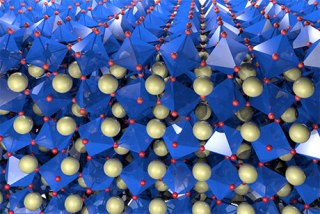Feb 26 2015
Scientists from Cornell University have used the spin-orbit interaction effect to tune the properties of materials. They have conducted research on the ways in which different “knobs” can alter material properties, techniques which were formerly unknown or misunderstood. Controlling material properties is the key to exploring or designing new materials.
 An artist’s rendering of strontium iridate, an oxide whose properties can be controlled by applying spin-orbit interactions or changing molecular bond angles. (Image credit: Brendan Faeth)
An artist’s rendering of strontium iridate, an oxide whose properties can be controlled by applying spin-orbit interactions or changing molecular bond angles. (Image credit: Brendan Faeth)
“The ultimate goal is to control electronic and magnetic properties of new materials using various knobs,” said Kyle Shen, associate professor of physics, who led the study published in Physical Review Letters in January. “What you want is to turn one knob, change some parameter, and turn a material from this to that.”
The normal techniques of modifying material properties include injecting impurities like chemical dopants, or altering their atomic structures. In this particular research, they used the spin-orbit interaction effect, which is similar to what an electron undergoes whilst traveling past another charged entity, such as the atomic nucleus, and this is obvious in heavier elements found closer to the bottom row of the periodic table.
Transition metal oxides are typical complex electronic materials. Here the metal is generally a lighter element such as manganese, copper, nickel or titanium. In this research study, Shen and his team substituted the lighter transition metal with an element that is very heavy such as iridium. Iridium is a very rare element mostly present in meteorites. In the compound strontium iridate (SrIrO3), this substitution significantly improved the spin-orbit interaction effect.
It was noticed that if spin-orbit interactions were not present, according to theoretical calculations, strontium iridate would behave as a traditional metal. However, the researchers concluded that the strong spin-orbit interactions caused strontium iridate properties to lie in-between that of a metal and a semiconductor, resulting in a “semimetal.”
When minor disturbances occur in the crystal structure, it causes the material to transit from an insulating structure to a metallic structure, thereby indicating that the spin-orbit interaction is very likely to be a novel technique for manipulating the electronic properties of composite materials.
The lead authors on the paper, “Interplay of Spin-Orbit Interactions, Dimensionality and Octahedral Rotations in Semimetallic SrIrO3” were former postdoctoral scholars Yuefeng Nie (now at Nanjing University), and Phil King (a Kavli Postdoctoral Fellow, now at St. Andrews' University).
The team included Darrell Schlom, the Herbert Fisk Johnson Professor of Industrial Engineering in the Department of Materials Science and Engineering, and Craig Fennie, associate professor of applied and engineering physics. Jacob Ruff, a staff scientist at the Cornell High Energy Synchrotron Source, assisted with vital X-ray measurements of atomic structures.
The Kavli Institute at Cornell for Nanoscale Science, the National Science Foundation, the Cornell Center for Materials Research, and the Air Force Office of Scientific Research supported the research.